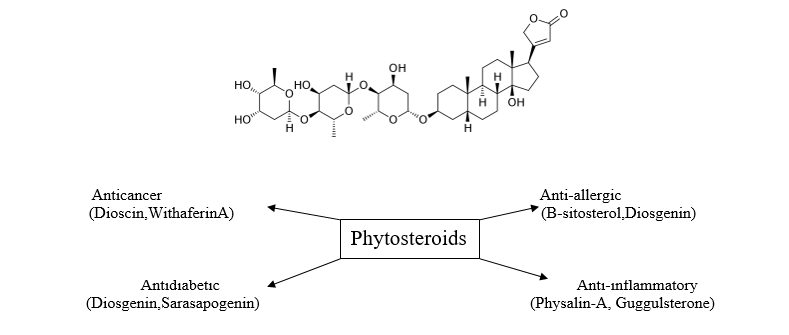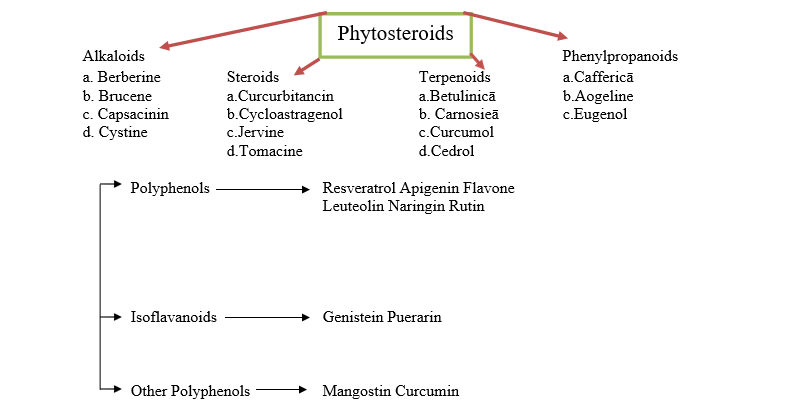- Home
- Up to XII Students
- Decide Stream For XI & XII
- Career Options
- Entrance Preparation
- Sample Papers
- Entrance Exams after 12th
- International Entrance Exams To Study Abroad
- Foreign University Comparison
- Apply to Foreign Universities
- General Preparation For Students Going To Study Abroad
- Write A Report
- Write an Article
- Write An Essay
- Important Dates
- UG & PG
- Tech Tips
- Mock Test
- GROOMING
- HOBBIES
- K PLUS
- Working Professional
- OTHERS
Optimizing Phytosteroids for Clinical Applications
Deependra Soni
Faculty of Pharmacy,
Klainga University, Naya Raipur
Phytosteroids are chemical entities that are derived from plants and have a steroidal origin. Various steroids have been isolated from plants and are in traditional practice since civilization for example steroids derived from Digitalis are the most important agents acting as cardio-tonics.
 The above-illustrated diagram is just a representation of some of the characteristics activities exhibited by the phytosteroids. Broadly we can also term “Phytosteroids” as “Brassinosteroids” which are derived from plants. A class of phytosteroids has remarkable estrogen effects and are termed “Phytosteroids”. They exert some action like human estrogen and are also structurally identical. These phytosteroids have multiple actions on the target site i.e., they can act as antagemist, as against, or may sometimes exert mixed action on the receptors. Phytosteroids can be classified into two ways:-
The above-illustrated diagram is just a representation of some of the characteristics activities exhibited by the phytosteroids. Broadly we can also term “Phytosteroids” as “Brassinosteroids” which are derived from plants. A class of phytosteroids has remarkable estrogen effects and are termed “Phytosteroids”. They exert some action like human estrogen and are also structurally identical. These phytosteroids have multiple actions on the target site i.e., they can act as antagemist, as against, or may sometimes exert mixed action on the receptors. Phytosteroids can be classified into two ways:-
 These phytosteroids are not only pharmacologically active but also have other nutritional value. Many of the phytosteroids can be replenished by maintaining the proper nutritional diet. The human body not only needs food but for daily activity but also require nutritional supplements to maintain the overall immunity of the body. The best part of phytosteroids is they are biological substances having the least side effects and are biologically compatible. Various studies and researches have postulated that phytosteroids can mimic the action of the synthetic drug but can also limit their use in certain diseases, etc.
Optimization of Phytosteroids in Clinical application can be done by scientific validation of their biological actions as well as formulating it into a suitable form for rational use and patient compliance. Phytosteroids in one way or the other are available in fruits, vegetables, vegetable oils, whole grains, soybeans, mushrooms, lentils, and nuts. Nowadays phytosterols (a kind of phytosteroid) are available commercially in the form of prepared foods like juices, yogurt, breakfast bars, salad dressings, etc, and are additionally are fortified with other nutritional elements also to boost the body’s immune function and capability. They are available in the form of supplements and are sold over the counter. The applicability of these compounds also depends on their health effect and availability of resource regeneration. From a research point of view, the time is not so far when the mode of drug regimen will be soon replaced by phytosteroids for a better future in health.
References :
These phytosteroids are not only pharmacologically active but also have other nutritional value. Many of the phytosteroids can be replenished by maintaining the proper nutritional diet. The human body not only needs food but for daily activity but also require nutritional supplements to maintain the overall immunity of the body. The best part of phytosteroids is they are biological substances having the least side effects and are biologically compatible. Various studies and researches have postulated that phytosteroids can mimic the action of the synthetic drug but can also limit their use in certain diseases, etc.
Optimization of Phytosteroids in Clinical application can be done by scientific validation of their biological actions as well as formulating it into a suitable form for rational use and patient compliance. Phytosteroids in one way or the other are available in fruits, vegetables, vegetable oils, whole grains, soybeans, mushrooms, lentils, and nuts. Nowadays phytosterols (a kind of phytosteroid) are available commercially in the form of prepared foods like juices, yogurt, breakfast bars, salad dressings, etc, and are additionally are fortified with other nutritional elements also to boost the body’s immune function and capability. They are available in the form of supplements and are sold over the counter. The applicability of these compounds also depends on their health effect and availability of resource regeneration. From a research point of view, the time is not so far when the mode of drug regimen will be soon replaced by phytosteroids for a better future in health.
References :
 The above-illustrated diagram is just a representation of some of the characteristics activities exhibited by the phytosteroids. Broadly we can also term “Phytosteroids” as “Brassinosteroids” which are derived from plants. A class of phytosteroids has remarkable estrogen effects and are termed “Phytosteroids”. They exert some action like human estrogen and are also structurally identical. These phytosteroids have multiple actions on the target site i.e., they can act as antagemist, as against, or may sometimes exert mixed action on the receptors. Phytosteroids can be classified into two ways:-
The above-illustrated diagram is just a representation of some of the characteristics activities exhibited by the phytosteroids. Broadly we can also term “Phytosteroids” as “Brassinosteroids” which are derived from plants. A class of phytosteroids has remarkable estrogen effects and are termed “Phytosteroids”. They exert some action like human estrogen and are also structurally identical. These phytosteroids have multiple actions on the target site i.e., they can act as antagemist, as against, or may sometimes exert mixed action on the receptors. Phytosteroids can be classified into two ways:-
- Based on chemical structure, they possess like Diosgenin (Sapogenin class) (Phytosterols, flavonoids) (alkaloids polyphenol, etc)
- Based on pharmacological action, they exert like anti-rheumatic, antioxidant, anticancer, etc.
 These phytosteroids are not only pharmacologically active but also have other nutritional value. Many of the phytosteroids can be replenished by maintaining the proper nutritional diet. The human body not only needs food but for daily activity but also require nutritional supplements to maintain the overall immunity of the body. The best part of phytosteroids is they are biological substances having the least side effects and are biologically compatible. Various studies and researches have postulated that phytosteroids can mimic the action of the synthetic drug but can also limit their use in certain diseases, etc.
Optimization of Phytosteroids in Clinical application can be done by scientific validation of their biological actions as well as formulating it into a suitable form for rational use and patient compliance. Phytosteroids in one way or the other are available in fruits, vegetables, vegetable oils, whole grains, soybeans, mushrooms, lentils, and nuts. Nowadays phytosterols (a kind of phytosteroid) are available commercially in the form of prepared foods like juices, yogurt, breakfast bars, salad dressings, etc, and are additionally are fortified with other nutritional elements also to boost the body’s immune function and capability. They are available in the form of supplements and are sold over the counter. The applicability of these compounds also depends on their health effect and availability of resource regeneration. From a research point of view, the time is not so far when the mode of drug regimen will be soon replaced by phytosteroids for a better future in health.
References :
These phytosteroids are not only pharmacologically active but also have other nutritional value. Many of the phytosteroids can be replenished by maintaining the proper nutritional diet. The human body not only needs food but for daily activity but also require nutritional supplements to maintain the overall immunity of the body. The best part of phytosteroids is they are biological substances having the least side effects and are biologically compatible. Various studies and researches have postulated that phytosteroids can mimic the action of the synthetic drug but can also limit their use in certain diseases, etc.
Optimization of Phytosteroids in Clinical application can be done by scientific validation of their biological actions as well as formulating it into a suitable form for rational use and patient compliance. Phytosteroids in one way or the other are available in fruits, vegetables, vegetable oils, whole grains, soybeans, mushrooms, lentils, and nuts. Nowadays phytosterols (a kind of phytosteroid) are available commercially in the form of prepared foods like juices, yogurt, breakfast bars, salad dressings, etc, and are additionally are fortified with other nutritional elements also to boost the body’s immune function and capability. They are available in the form of supplements and are sold over the counter. The applicability of these compounds also depends on their health effect and availability of resource regeneration. From a research point of view, the time is not so far when the mode of drug regimen will be soon replaced by phytosteroids for a better future in health.
References :
- Jones, P. J., and Abumweis, S. S. (2009). Phytosterols as functional food ingredients: linkages to cardiovascular disease and cancer. Opin. Clin. Nutr. Metab. Care12, 147–151. doi:10.1097/mco.0b013e328326770f
- Jones P. J., Vanstone C. A., Raeini-Sarjaz M., St-Onge M. P. (2003). Phytosterols in low- and nonfat beverages as part of a controlled diet fail to lower plasma lipid levels. Lipid Res.44, 1713–1719. 10.1194/jlr.M300089-JLR200
- Jiang L., Zhao X., Xu J., Li C., Yu Y., Wang W., et al. (2019). The protective effect of dietary phytosterols on cancer risk: a systematic meta-analysis. J Oncol2019, 7479518 10.1155/2019/7479518
Like this article?
Share on Facebook
Share on Twitter
Share on Linkdin
Share on Pinterest

Kalinga Plus is an initiative by Kalinga University, Raipur. The main objective of this to disseminate knowledge and guide students & working professionals.
This platform will guide pre – post university level students.
Pre University Level – IX –XII grade students when they decide streams and choose their career
Post University level – when A student joins corporate & needs to handle the workplace challenges effectively.
We are hopeful that you will find lot of knowledgeable & interesting information here.
Happy surfing!!
- →
-
Free Counseling!
